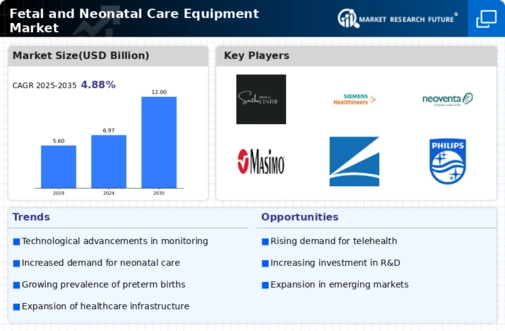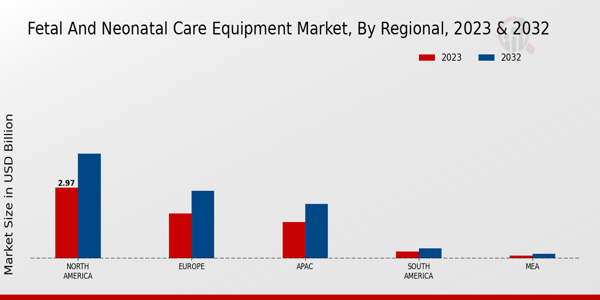Market Growth Projections
The Global Fetal and Neonatal Care Equipment Market Industry is projected to experience substantial growth in the coming years. With an estimated market value of 6.97 USD Billion in 2024, the industry is on a trajectory to reach 12.0 USD Billion by 2035. This growth reflects a compound annual growth rate of 5.06% from 2025 to 2035, indicating a robust demand for innovative solutions in fetal and neonatal care. Factors such as technological advancements, increasing awareness of maternal health, and rising birth rates in developing regions are likely to drive this expansion. The market's growth potential presents opportunities for stakeholders to invest in research and development, ultimately enhancing care for vulnerable populations.
Government Initiatives and Funding
Government initiatives and funding aimed at improving maternal and neonatal health are pivotal drivers of the Global Fetal and Neonatal Care Equipment Market Industry. Various countries are implementing policies to enhance healthcare infrastructure, particularly in developing regions. For instance, initiatives that focus on increasing access to prenatal and neonatal care services are likely to boost the demand for specialized equipment. Additionally, funding programs that support research and development in neonatal technologies further stimulate market growth. As these initiatives gain momentum, they are expected to contribute to a compound annual growth rate of 5.06% from 2025 to 2035, indicating a robust market trajectory.
Rising Birth Rates in Developing Regions
The rising birth rates in developing regions are a notable driver for the Global Fetal and Neonatal Care Equipment Market Industry. As populations grow, the demand for maternal and neonatal healthcare services intensifies, leading to an increased need for specialized equipment. Countries in Africa and Asia, where birth rates remain high, are particularly impacted. This surge in demand is prompting healthcare facilities to invest in advanced fetal and neonatal care technologies to ensure better outcomes for mothers and infants. Consequently, this trend is expected to contribute to the overall market growth, aligning with the projected increase in market value over the coming years.
Rising Prevalence of Neonatal Conditions
The increasing prevalence of neonatal conditions globally is a significant driver for the Global Fetal and Neonatal Care Equipment Market Industry. Conditions such as preterm birth and low birth weight are on the rise, necessitating advanced medical equipment for effective management. For instance, the World Health Organization indicates that approximately 15 million babies are born preterm each year, highlighting the urgent need for specialized care. This growing patient population is expected to contribute to the market's expansion, with projections estimating the market value to reach 6.97 USD Billion in 2024, further emphasizing the demand for innovative fetal and neonatal care solutions.
Technological Advancements in Medical Equipment
Technological advancements play a crucial role in shaping the Global Fetal and Neonatal Care Equipment Market Industry. Innovations such as non-invasive monitoring systems, advanced incubators, and portable ultrasound devices enhance the quality of care provided to neonates. These technologies not only improve patient outcomes but also streamline clinical workflows. For example, the integration of artificial intelligence in monitoring systems allows for real-time data analysis, enabling timely interventions. As healthcare facilities increasingly adopt these advanced technologies, the market is projected to grow significantly, with an anticipated value of 12.0 USD Billion by 2035, reflecting the ongoing evolution in neonatal care.
Increasing Awareness of Maternal and Infant Health
The growing awareness of maternal and infant health issues is driving demand within the Global Fetal and Neonatal Care Equipment Market Industry. Educational campaigns and community outreach programs are emphasizing the importance of prenatal care and early detection of potential complications. This heightened awareness encourages expectant parents to seek medical assistance, thereby increasing the utilization of fetal and neonatal care equipment. Furthermore, healthcare providers are prioritizing training and education on the latest technologies, ensuring that they are well-equipped to handle complex cases. This trend is likely to sustain market growth as more families recognize the value of advanced neonatal care.

















